lock MAZDA MODEL 3 HATCHBACK 2006 (in English) User Guide
[x] Cancel search | Manufacturer: MAZDA, Model Year: 2006, Model line: MODEL 3 HATCHBACK, Model: MAZDA MODEL 3 HATCHBACK 2006Pages: 372, PDF Size: 5.55 MB
Page 25 of 372
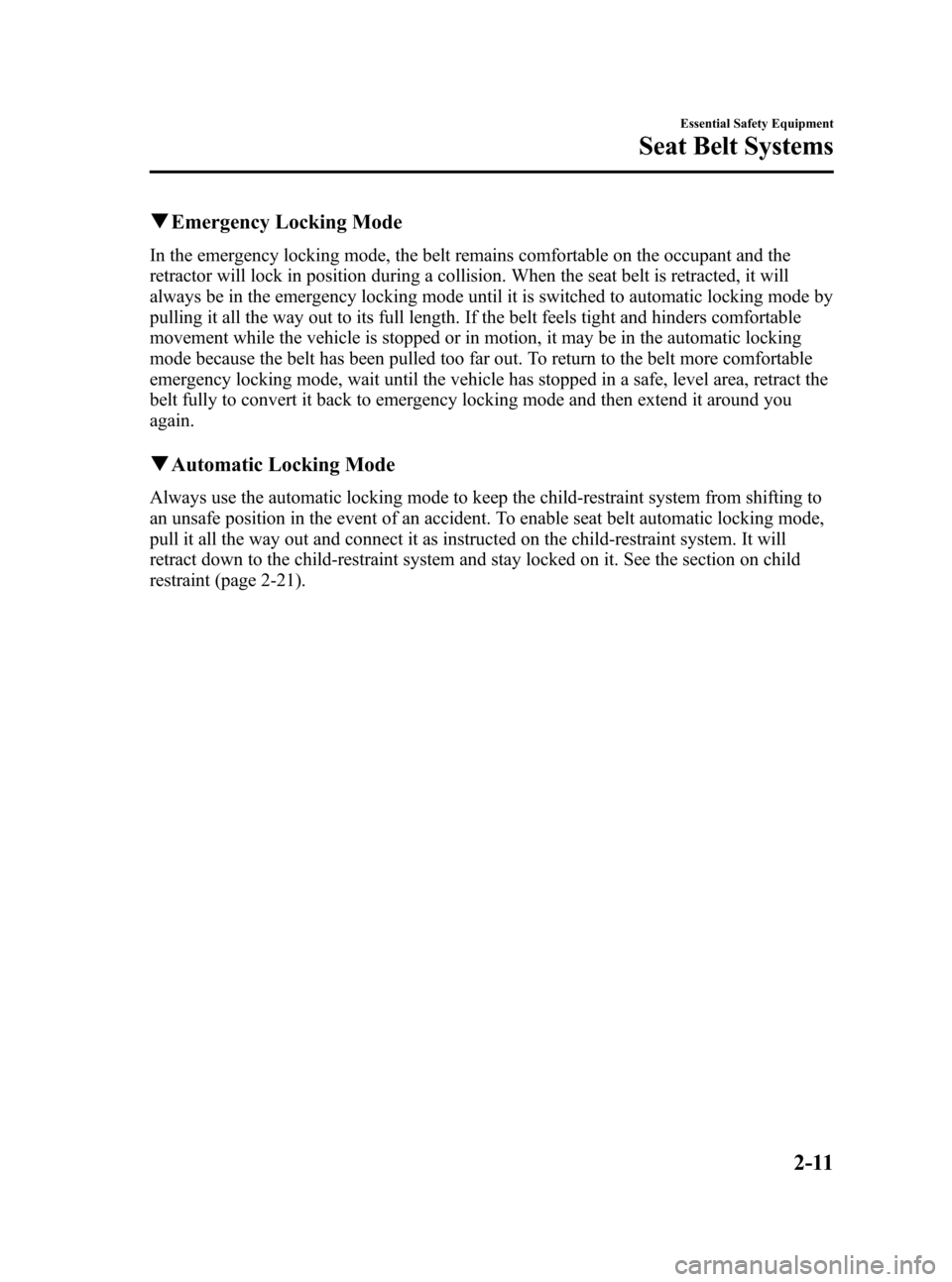
Black plate (25,1)
qEmergency Locking Mode
In the emergency locking mode, the belt remains comfortable on the occupant and the
retractor will lock in position during a collision. When the seat belt is retracted, it will
always be in the emergency locking mode until it is switched to automatic locking mode by
pulling it all the way out to its full length. If the belt feels tight and hinders comfortable
movement while the vehicle is stopped or in motion, it may be in the automatic locking
mode because the belt has been pulled too far out. To return to the belt more comfortable
emergency locking mode, wait until the vehicle has stopped in a safe, level area, retract the
belt fully to convert it back to emergency locking mode and then extend it around you
again.
qAutomatic Locking Mode
Always use the automatic locking mode to keep the child-restraint system from shifting to
an unsafe position in the event of an accident. To enable seat belt automatic locking mode,
pull it all the way out and connect it as instructed on the child-restraint system. It will
retract down to the child-restraint system and stay locked on it. See the section on child
restraint (page 2-21).
Essential Safety Equipment
Seat Belt Systems
2-11
Mazda3_8U55-EA-05G_Edition2 Page25
Thursday, June 23 2005 2:52 PM
Form No.8U55-EA-05G
Page 27 of 372
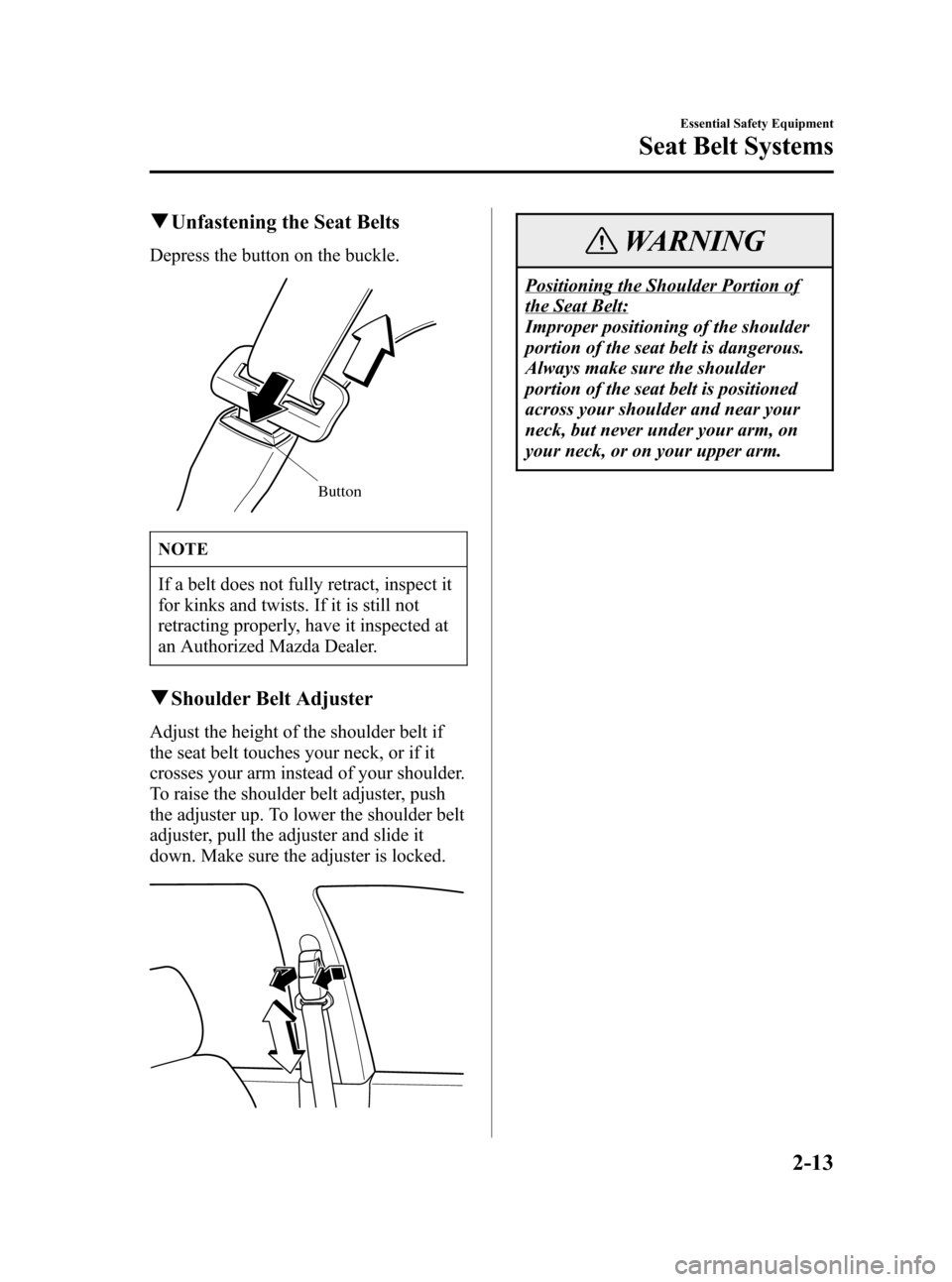
Black plate (27,1)
qUnfastening the Seat Belts
Depress the button on the buckle.
Button
NOTE
If a belt does not fully retract, inspect it
for kinks and twists. If it is still not
retracting properly, have it inspected at
an Authorized Mazda Dealer.
qShoulder Belt Adjuster
Adjust the height of the shoulder belt if
the seat belt touches your neck, or if it
crosses your arm instead of your shoulder.
To raise the shoulder belt adjuster, push
the adjuster up. To lower the shoulder belt
adjuster, pull the adjuster and slide it
down. Make sure the adjuster is locked.
WARNING
Positioning the Shoulder Portion of
the Seat Belt:
Improper positioning of the shoulder
portion of the seat belt is dangerous.
Always make sure the shoulder
portion of the seat belt is positioned
across your shoulder and near your
neck, but never under your arm, on
your neck, or on your upper arm.
Essential Safety Equipment
Seat Belt Systems
2-13
Mazda3_8U55-EA-05G_Edition2 Page27
Thursday, June 23 2005 2:52 PM
Form No.8U55-EA-05G
Page 37 of 372
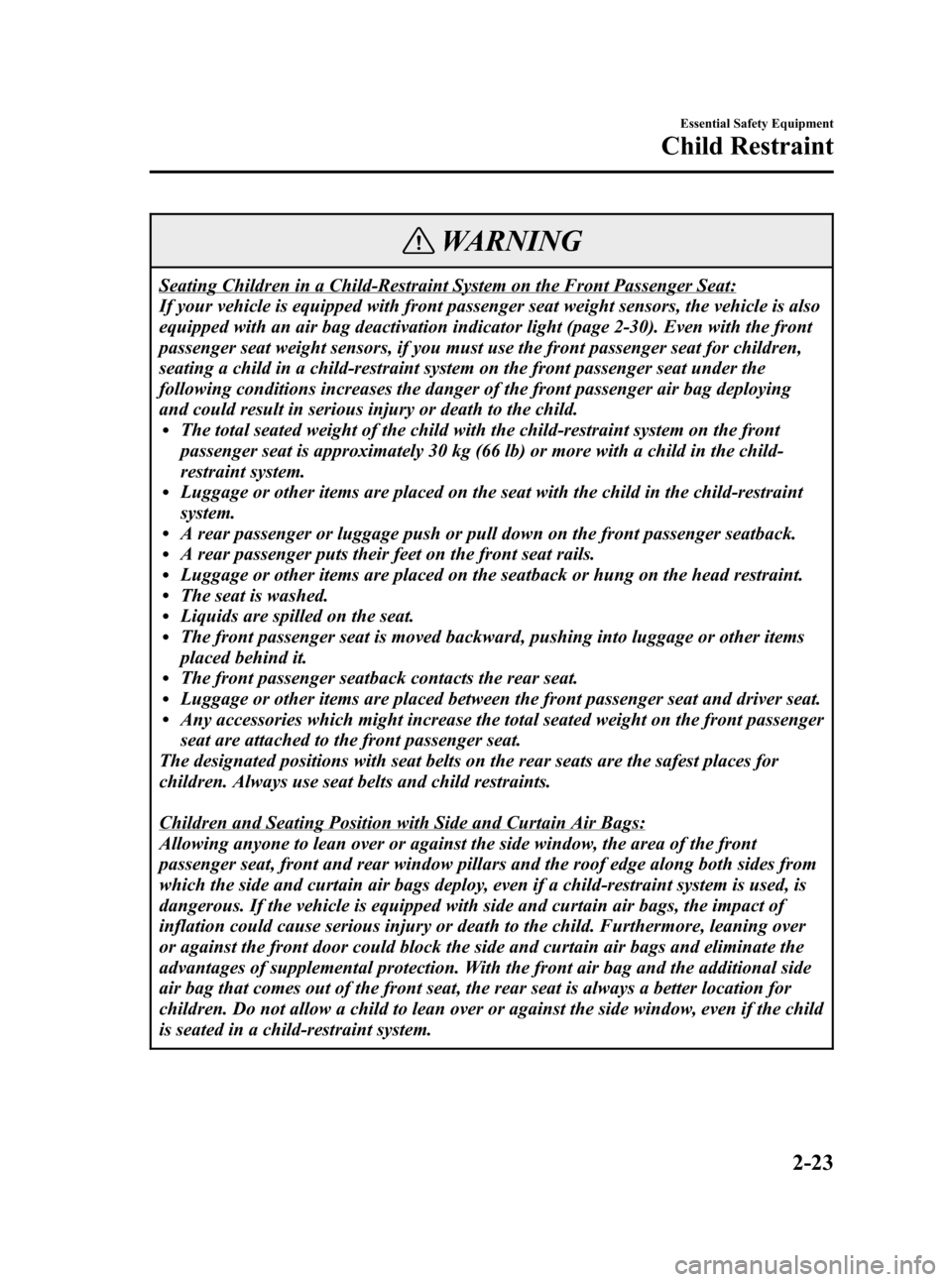
Black plate (37,1)
WARNING
Seating Children in a Child-Restraint System on the Front Passenger Seat:
If your vehicle is equipped with front passenger seat weight sensors, the vehicle is also
equipped with an air bag deactivation indicator light (page 2-30). Even with the front
passenger seat weight sensors, if you must use the front passenger seat for children,
seating a child in a child-restraint system on the front passenger seat under the
following conditions increases the danger of the front passenger air bag deploying
and could result in serious injury or death to the child.
lThe total seated weight of the child with the child-restraint system on the front
passenger seat is approximately 30 kg (66 lb) or more with a child in the child-
restraint system.
lLuggage or other items are placed on the seat with the child in the child-restraint
system.
lA rear passenger or luggage push or pull down on the front passenger seatback.lA rear passenger puts their feet on the front seat rails.lLuggage or other items are placed on the seatback or hung on the head restraint.lThe seat is washed.lLiquids are spilled on the seat.lThe front passenger seat is moved backward, pushing into luggage or other items
placed behind it.
lThe front passenger seatback contacts the rear seat.lLuggage or other items are placed between the front passenger seat and driver seat.lAny accessories which might increase the total seated weight on the front passenger
seat are attached to the front passenger seat.
The designated positions with seat belts on the rear seats are the safest places for
children. Always use seat belts and child restraints.
Children and Seating Position with Side and Curtain Air Bags:
Allowing anyone to lean over or against the side window, the area of the front
passenger seat, front and rear window pillars and the roof edge along both sides from
which the side and curtain air bags deploy, even if a child-restraint system is used, is
dangerous. If the vehicle is equipped with side and curtain air bags, the impact of
inflation could cause serious injury or death to the child. Furthermore, leaning over
or against the front door could block the side and curtain air bags and eliminate the
advantages of supplemental protection. With the front air bag and the additional side
air bag that comes out of the front seat, the rear seat is always a better location for
children. Do not allow a child to lean over or against the side window, even if the child
is seated in a child-restraint system.
Essential Safety Equipment
Child Restraint
2-23
Mazda3_8U55-EA-05G_Edition2 Page37
Thursday, June 23 2005 2:53 PM
Form No.8U55-EA-05G
Page 39 of 372
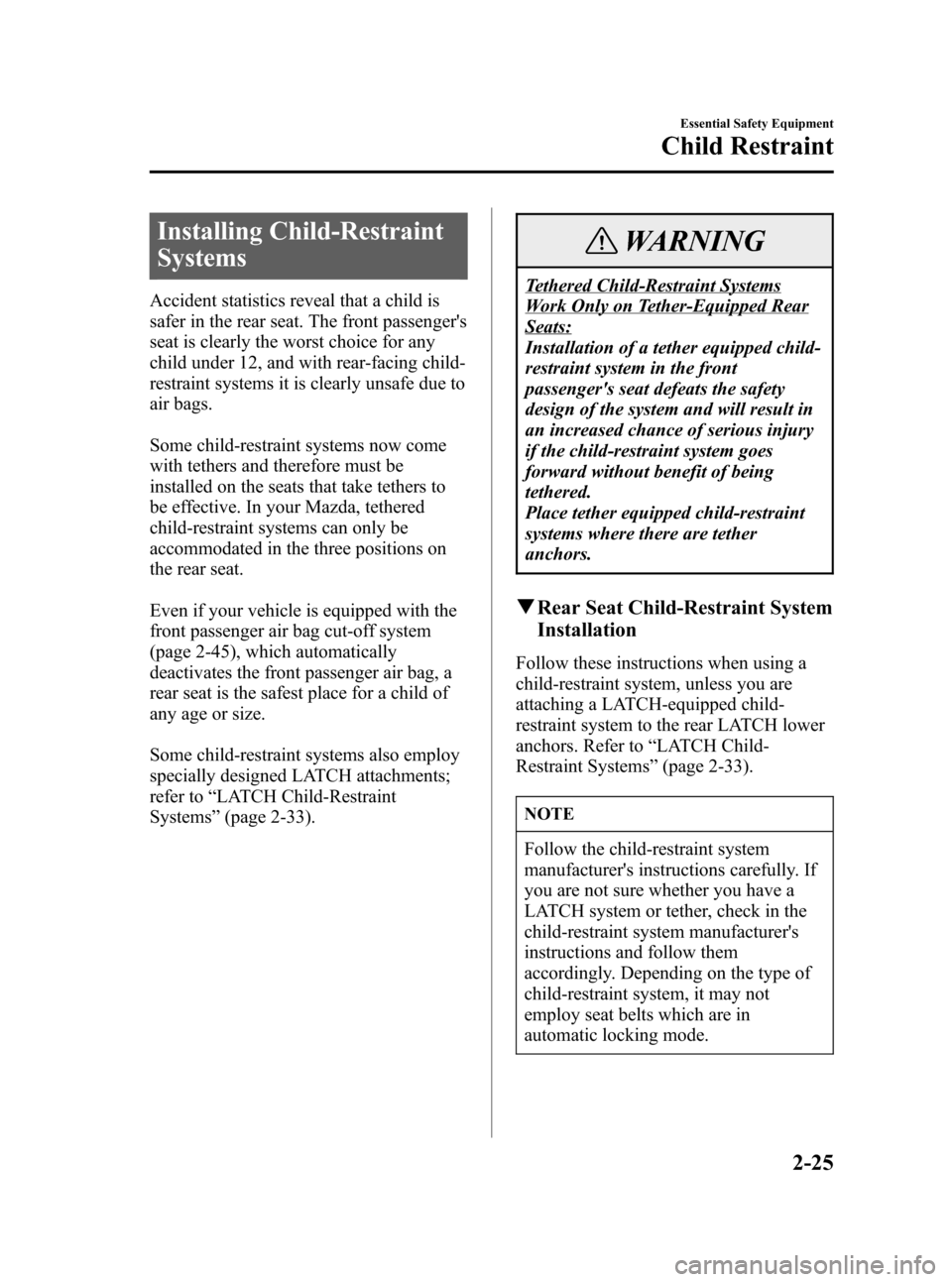
Black plate (39,1)
Installing Child-Restraint
Systems
Accident statistics reveal that a child is
safer in the rear seat. The front passenger's
seat is clearly the worst choice for any
child under 12, and with rear-facing child-
restraint systems it is clearly unsafe due to
air bags.
Some child-restraint systems now come
with tethers and therefore must be
installed on the seats that take tethers to
be effective. In your Mazda, tethered
child-restraint systems can only be
accommodated in the three positions on
the rear seat.
Even if your vehicle is equipped with the
front passenger air bag cut-off system
(page 2-45), which automatically
deactivates the front passenger air bag, a
rear seat is the safest place for a child of
any age or size.
Some child-restraint systems also employ
specially designed LATCH attachments;
refer to“LATCH Child-Restraint
Systems”(page 2-33).
WARNING
Tethered Child-Restraint Systems
Work Only on Tether-Equipped Rear
Seats:
Installation of a tether equipped child-
restraint system in the front
passenger's seat defeats the safety
design of the system and will result in
an increased chance of serious injury
if the child-restraint system goes
forward without benefit of being
tethered.
Place tether equipped child-restraint
systems where there are tether
anchors.
qRear Seat Child-Restraint System
Installation
Follow these instructions when using a
child-restraint system, unless you are
attaching a LATCH-equipped child-
restraint system to the rear LATCH lower
anchors. Refer to“LATCH Child-
Restraint Systems”(page 2-33).
NOTE
Follow the child-restraint system
manufacturer's instructions carefully. If
you are not sure whether you have a
LATCH system or tether, check in the
child-restraint system manufacturer's
instructions and follow them
accordingly. Depending on the type of
child-restraint system, it may not
employ seat belts which are in
automatic locking mode.
Essential Safety Equipment
Child Restraint
2-25
Mazda3_8U55-EA-05G_Edition2 Page39
Thursday, June 23 2005 2:53 PM
Form No.8U55-EA-05G
Page 40 of 372
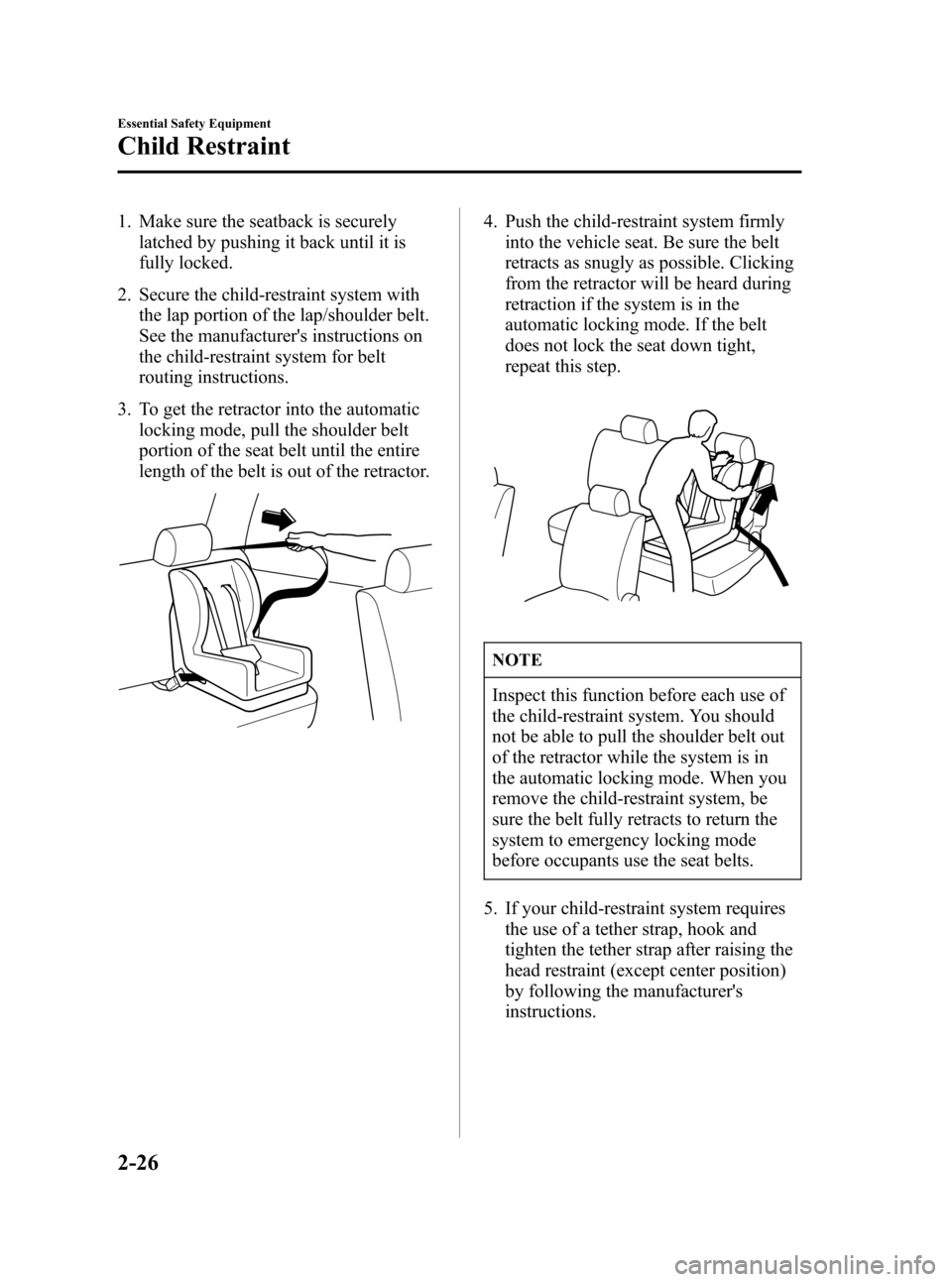
Black plate (40,1)
1. Make sure the seatback is securely
latched by pushing it back until it is
fully locked.
2. Secure the child-restraint system with
the lap portion of the lap/shoulder belt.
See the manufacturer's instructions on
the child-restraint system for belt
routing instructions.
3. To get the retractor into the automatic
locking mode, pull the shoulder belt
portion of the seat belt until the entire
length of the belt is out of the retractor.4. Push the child-restraint system firmly
into the vehicle seat. Be sure the belt
retracts as snugly as possible. Clicking
from the retractor will be heard during
retraction if the system is in the
automatic locking mode. If the belt
does not lock the seat down tight,
repeat this step.
NOTE
Inspect this function before each use of
the child-restraint system. You should
not be able to pull the shoulder belt out
of the retractor while the system is in
the automatic locking mode. When you
remove the child-restraint system, be
sure the belt fully retracts to return the
system to emergency locking mode
before occupants use the seat belts.
5. If your child-restraint system requires
the use of a tether strap, hook and
tighten the tether strap after raising the
head restraint (except center position)
by following the manufacturer's
instructions.
2-26
Essential Safety Equipment
Child Restraint
Mazda3_8U55-EA-05G_Edition2 Page40
Thursday, June 23 2005 2:53 PM
Form No.8U55-EA-05G
Page 44 of 372
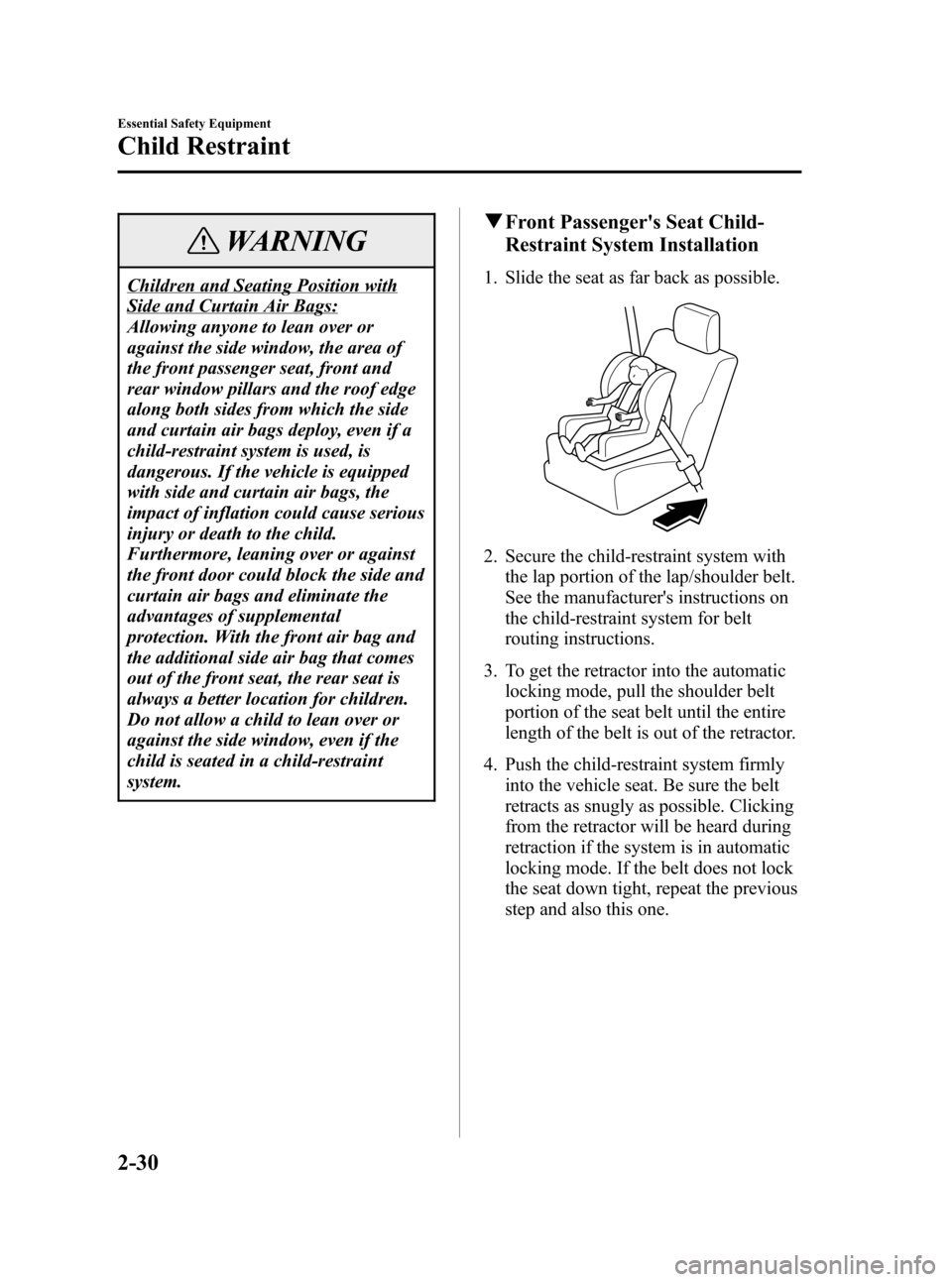
Black plate (44,1)
WARNING
Children and Seating Position with
Side and Curtain Air Bags:
Allowing anyone to lean over or
against the side window, the area of
the front passenger seat, front and
rear window pillars and the roof edge
along both sides from which the side
and curtain air bags deploy, even if a
child-restraint system is used, is
dangerous. If the vehicle is equipped
with side and curtain air bags, the
impact of inflation could cause serious
injury or death to the child.
Furthermore, leaning over or against
the front door could block the side and
curtain air bags and eliminate the
advantages of supplemental
protection. With the front air bag and
the additional side air bag that comes
out of the front seat, the rear seat is
always a better location for children.
Do not allow a child to lean over or
against the side window, even if the
child is seated in a child-restraint
system.
qFront Passenger's Seat Child-
Restraint System Installation
1. Slide the seat as far back as possible.
2. Secure the child-restraint system with
the lap portion of the lap/shoulder belt.
See the manufacturer's instructions on
the child-restraint system for belt
routing instructions.
3. To get the retractor into the automatic
locking mode, pull the shoulder belt
portion of the seat belt until the entire
length of the belt is out of the retractor.
4. Push the child-restraint system firmly
into the vehicle seat. Be sure the belt
retracts as snugly as possible. Clicking
from the retractor will be heard during
retraction if the system is in automatic
locking mode. If the belt does not lock
the seat down tight, repeat the previous
step and also this one.
2-30
Essential Safety Equipment
Child Restraint
Mazda3_8U55-EA-05G_Edition2 Page44
Thursday, June 23 2005 2:53 PM
Form No.8U55-EA-05G
Page 45 of 372
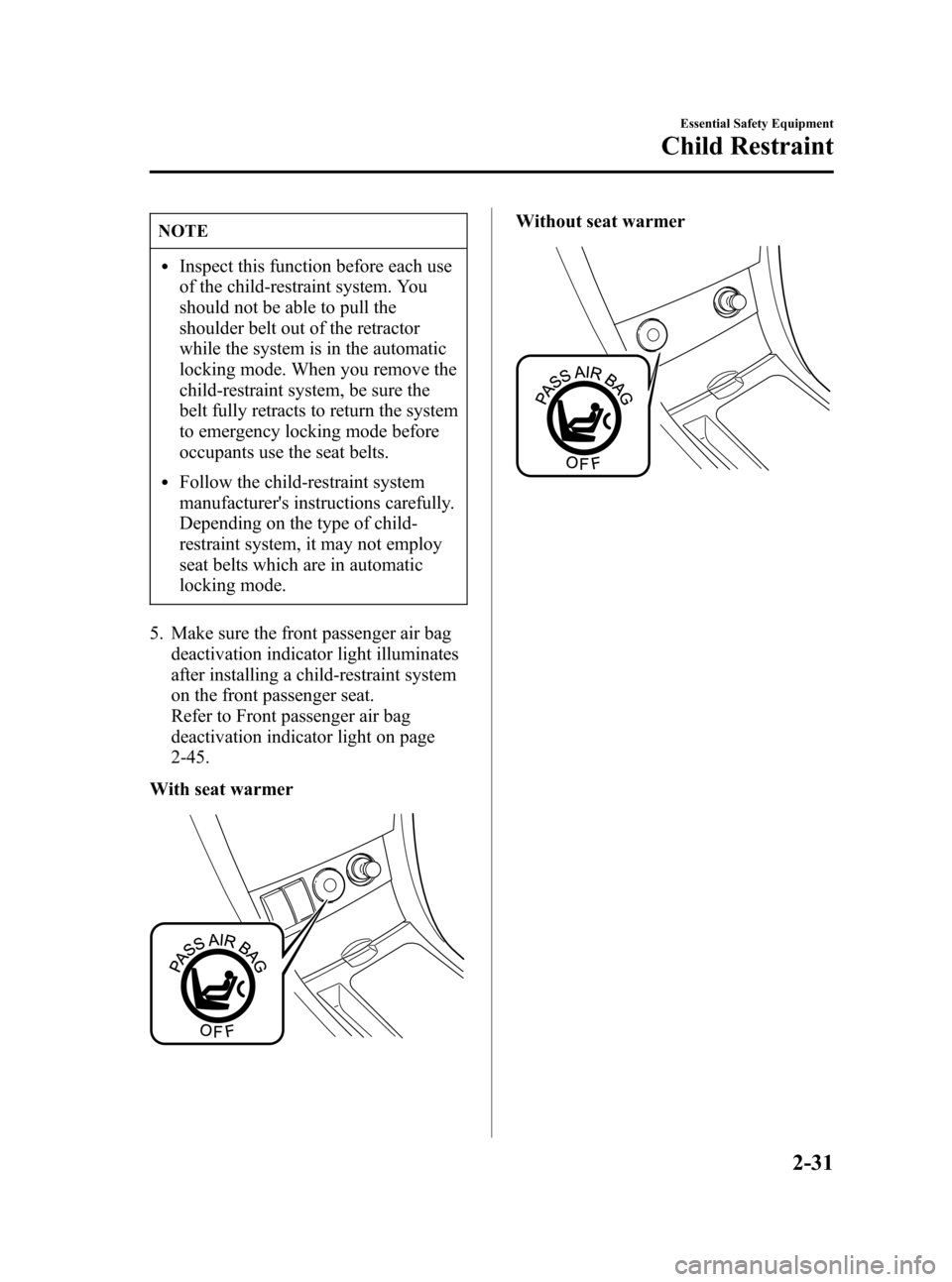
Black plate (45,1)
NOTE
lInspect this function before each use
of the child-restraint system. You
should not be able to pull the
shoulder belt out of the retractor
while the system is in the automatic
locking mode. When you remove the
child-restraint system, be sure the
belt fully retracts to return the system
to emergency locking mode before
occupants use the seat belts.
lFollow the child-restraint system
manufacturer's instructions carefully.
Depending on the type of child-
restraint system, it may not employ
seat belts which are in automatic
locking mode.
5. Make sure the front passenger air bag
deactivation indicator light illuminates
after installing a child-restraint system
on the front passenger seat.
Refer to Front passenger air bag
deactivation indicator light on page
2-45.
With seat warmer
Without seat warmer
Essential Safety Equipment
Child Restraint
2-31
Mazda3_8U55-EA-05G_Edition2 Page45
Thursday, June 23 2005 2:53 PM
Form No.8U55-EA-05G
Page 48 of 372
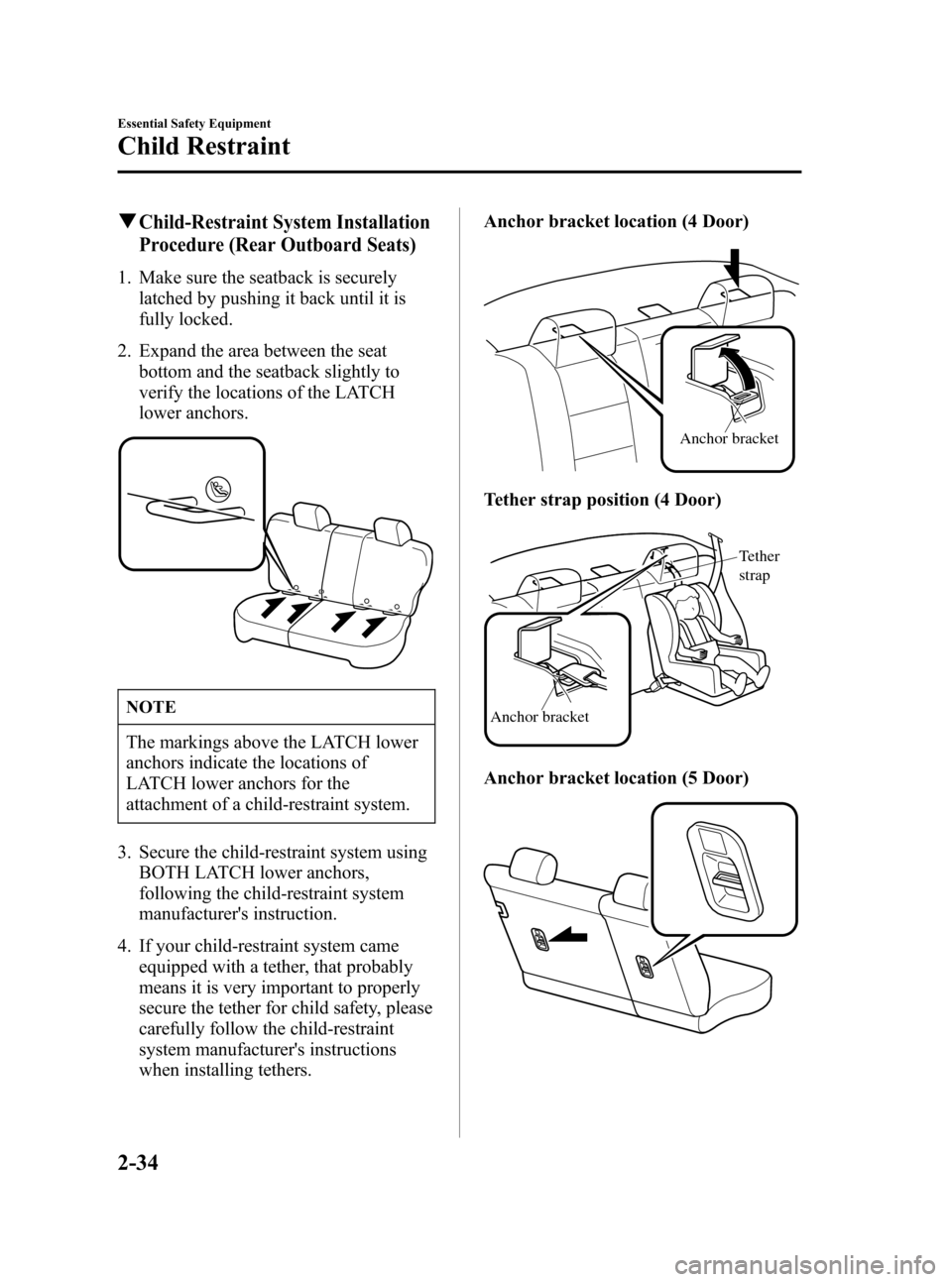
Black plate (48,1)
qChild-Restraint System Installation
Procedure (Rear Outboard Seats)
1. Make sure the seatback is securely
latched by pushing it back until it is
fully locked.
2. Expand the area between the seat
bottom and the seatback slightly to
verify the locations of the LATCH
lower anchors.
NOTE
The markings above the LATCH lower
anchors indicate the locations of
LATCH lower anchors for the
attachment of a child-restraint system.
3. Secure the child-restraint system using
BOTH LATCH lower anchors,
following the child-restraint system
manufacturer's instruction.
4. If your child-restraint system came
equipped with a tether, that probably
means it is very important to properly
secure the tether for child safety, please
carefully follow the child-restraint
system manufacturer's instructions
when installing tethers.Anchor bracket location (4 Door)
Anchor bracket
Tether strap position (4 Door)
Anchor bracketTether
strap
Anchor bracket location (5 Door)
2-34
Essential Safety Equipment
Child Restraint
Mazda3_8U55-EA-05G_Edition2 Page48
Thursday, June 23 2005 2:53 PM
Form No.8U55-EA-05G
Page 49 of 372
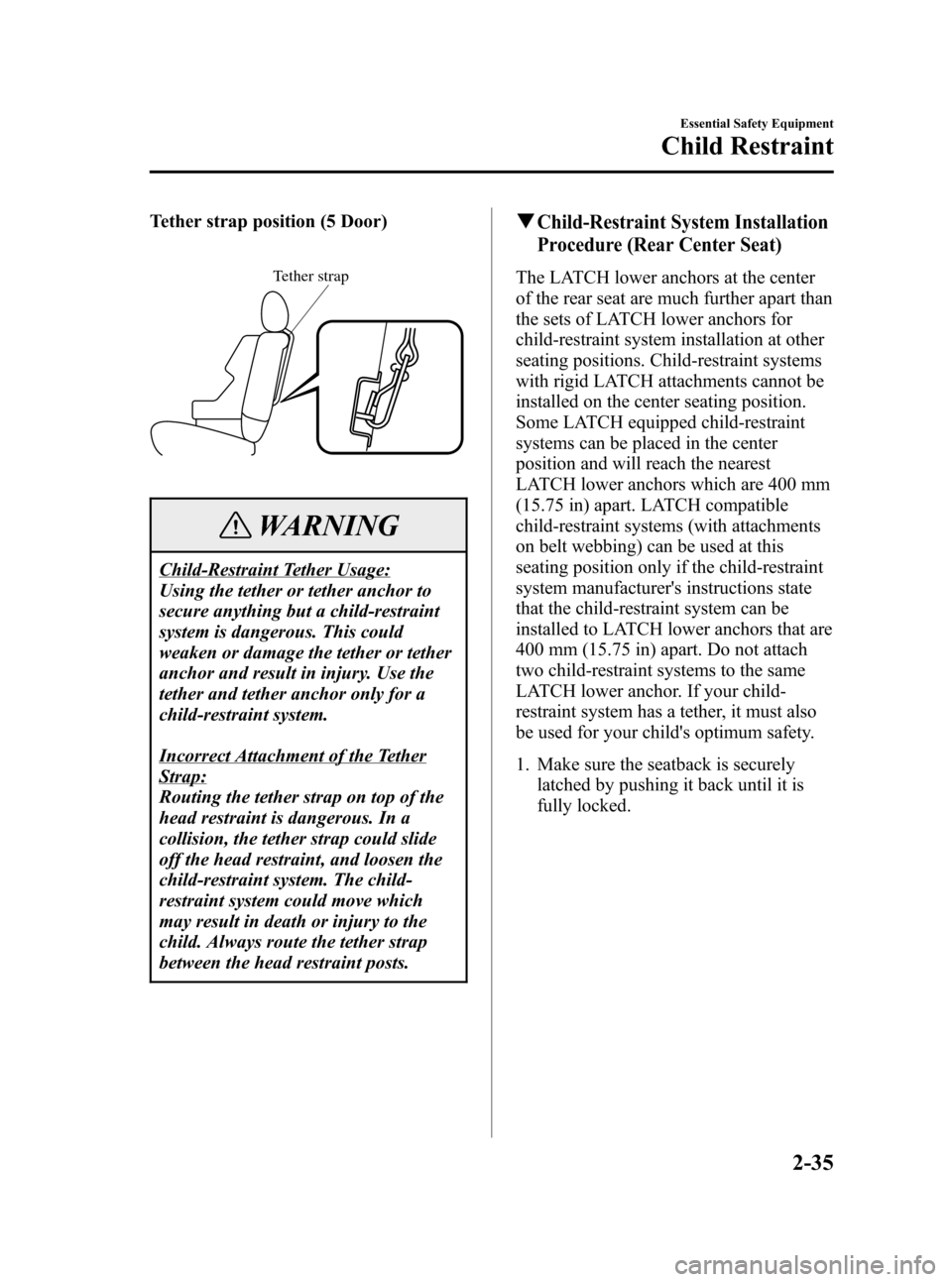
Black plate (49,1)
Tether strap position (5 Door)
Tether strap
WARNING
Child-Restraint Tether Usage:
Using the tether or tether anchor to
secure anything but a child-restraint
system is dangerous. This could
weaken or damage the tether or tether
anchor and result in injury. Use the
tether and tether anchor only for a
child-restraint system.
Incorrect Attachment of the Tether
Strap:
Routing the tether strap on top of the
head restraint is dangerous. In a
collision, the tether strap could slide
off the head restraint, and loosen the
child-restraint system. The child-
restraint system could move which
may result in death or injury to the
child. Always route the tether strap
between the head restraint posts.
qChild-Restraint System Installation
Procedure (Rear Center Seat)
The LATCH lower anchors at the center
of the rear seat are much further apart than
the sets of LATCH lower anchors for
child-restraint system installation at other
seating positions. Child-restraint systems
with rigid LATCH attachments cannot be
installed on the center seating position.
Some LATCH equipped child-restraint
systems can be placed in the center
position and will reach the nearest
LATCH lower anchors which are 400 mm
(15.75 in) apart. LATCH compatible
child-restraint systems (with attachments
on belt webbing) can be used at this
seating position only if the child-restraint
system manufacturer's instructions state
that the child-restraint system can be
installed to LATCH lower anchors that are
400 mm (15.75 in) apart. Do not attach
two child-restraint systems to the same
LATCH lower anchor. If your child-
restraint system has a tether, it must also
be used for your child's optimum safety.
1. Make sure the seatback is securely
latched by pushing it back until it is
fully locked.
Essential Safety Equipment
Child Restraint
2-35
Mazda3_8U55-EA-05G_Edition2 Page49
Thursday, June 23 2005 2:53 PM
Form No.8U55-EA-05G
Page 54 of 372
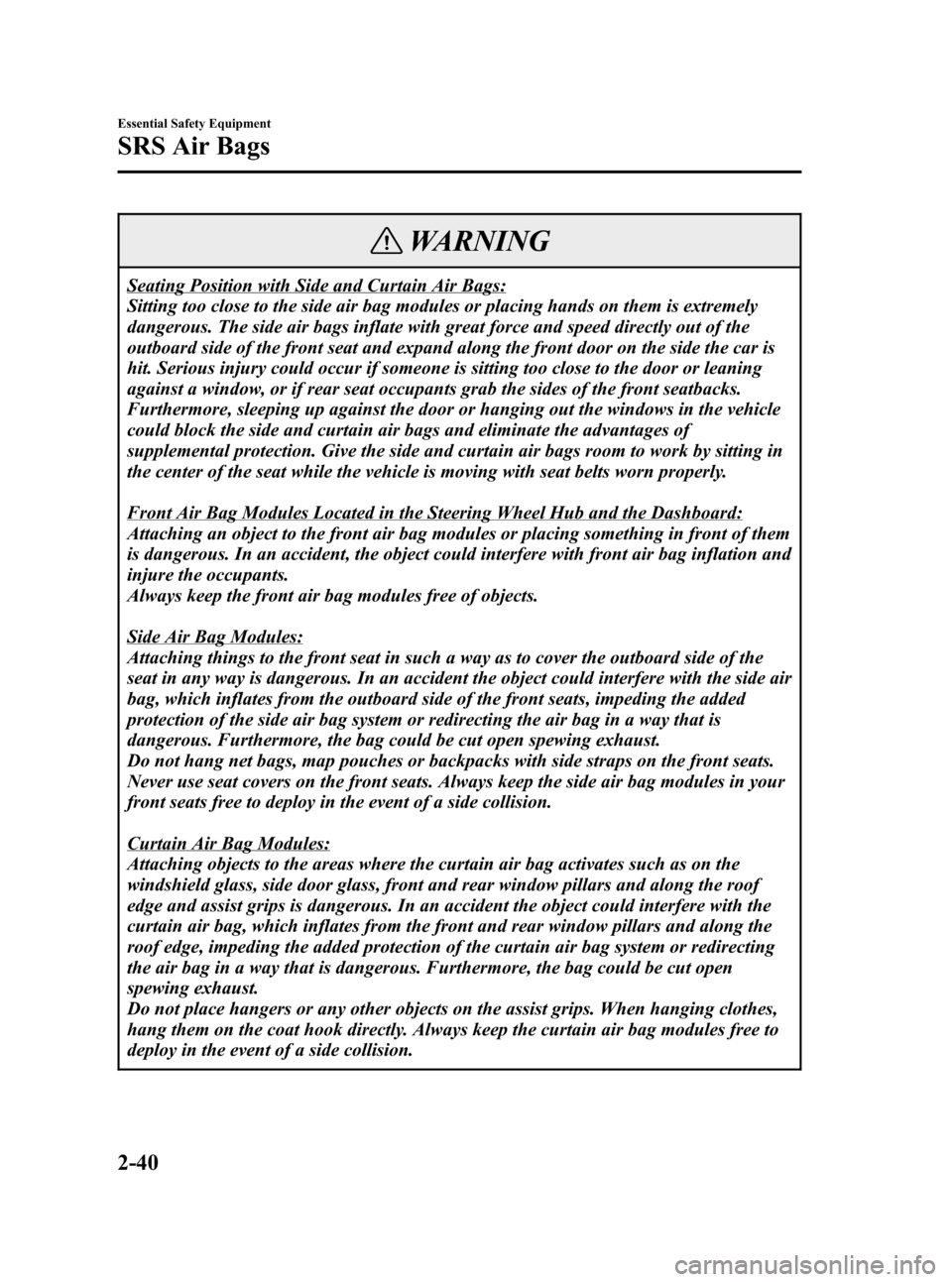
Black plate (54,1)
WARNING
Seating Position with Side and Curtain Air Bags:
Sitting too close to the side air bag modules or placing hands on them is extremely
dangerous. The side air bags inflate with great force and speed directly out of the
outboard side of the front seat and expand along the front door on the side the car is
hit. Serious injury could occur if someone is sitting too close to the door or leaning
against a window, or if rear seat occupants grab the sides of the front seatbacks.
Furthermore, sleeping up against the door or hanging out the windows in the vehicle
could block the side and curtain air bags and eliminate the advantages of
supplemental protection. Give the side and curtain air bags room to work by sitting in
the center of the seat while the vehicle is moving with seat belts worn properly.
Front Air Bag Modules Located in the Steering Wheel Hub and the Dashboard:
Attaching an object to the front air bag modules or placing something in front of them
is dangerous. In an accident, the object could interfere with front air bag inflation and
injure the occupants.
Always keep the front air bag modules free of objects.
Side Air Bag Modules:
Attaching things to the front seat in such a way as to cover the outboard side of the
seat in any way is dangerous. In an accident the object could interfere with the side air
bag, which inflates from the outboard side of the front seats, impeding the added
protection of the side air bag system or redirecting the air bag in a way that is
dangerous. Furthermore, the bag could be cut open spewing exhaust.
Do not hang net bags, map pouches or backpacks with side straps on the front seats.
Never use seat covers on the front seats. Always keep the side air bag modules in your
front seats free to deploy in the event of a side collision.
Curtain Air Bag Modules:
Attaching objects to the areas where the curtain air bag activates such as on the
windshield glass, side door glass, front and rear window pillars and along the roof
edge and assist grips is dangerous. In an accident the object could interfere with the
curtain air bag, which inflates from the front and rear window pillars and along the
roof edge, impeding the added protection of the curtain air bag system or redirecting
the air bag in a way that is dangerous. Furthermore, the bag could be cut open
spewing exhaust.
Do not place hangers or any other objects on the assist grips. When hanging clothes,
hang them on the coat hook directly. Always keep the curtain air bag modules free to
deploy in the event of a side collision.
2-40
Essential Safety Equipment
SRS Air Bags
Mazda3_8U55-EA-05G_Edition2 Page54
Thursday, June 23 2005 2:53 PM
Form No.8U55-EA-05G